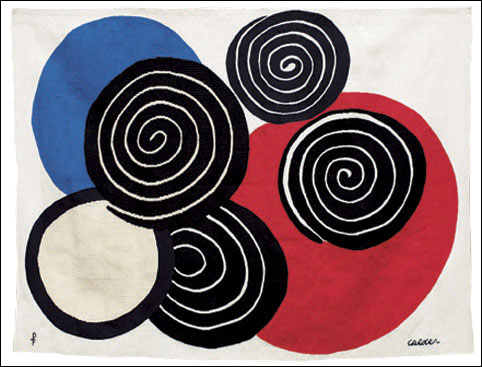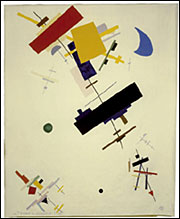With over forty works from prestigious, private collections, the Castle of Lavardens offers a new perspective of the art of weaving of the XXth century. The tapestries chosen are among the most representative of the artistic movements of the last fifty years. While not pretending to be exhaustive, the exibition focuses on giving a new visiblity to tapestry and tries to redefine more precisely its place in contemporary creation.
Because there are walls...
Why tapestry ? Lurçat would have said, «Because there are walls!» It is true that the Castle of Lavardens, which goes back to the XIIth century, is built entirely in freestone. Standing on four levels, its size and volume are impressive and it holds large rooms. This architectural ensemble demands monumental art, and by playing with the softness of the light and the whiteness of the walls that contrast with the brightness of the colors, tapesry is in the best frame possible. The exhibition covers some ten rooms, allowing us to admire works of very large dimensions. It is made up of three parts. The «Tribute» to tapestry designers who became famous thanks to their tapestry work: Jean Lurçat, Dom Robert, Mario Prassinos... «Recignition» of major artists of the XXth century who demonstrated their interest for this medium, such as Sonia Delaunay, Victor Vasarely, Marcel Gromaire, Le Corbusier. Last but not least, the «Innovation» of today’s creators such as Richard Texier, Henri Guérin, Jacques Haramburus.
The go-betweens
Tapestry is an art form as old as the hills, it exists ever since man intertwined two threads. It was particularly in the Middle Age that the walls of the castles were dressed up with these warm, easily transported woolen images. But, while this art was a major technique in the past centuries, it was progressively restricted to a decorative role, until it found its place again among the movements of contemporary art. While in the beginning of the XXth century tapestry was classified among patrimonial know-hows, in the 1940s a few artists dedicated themselves to give it a creative content again. These go-betweens that linked tradition to the art of this century quickly had followers and had tapestry spring on to the artistic scene. A decade later artistic competition pushed creators to experience new aesthetic forms, and in particular forms of abstraction, while searching for means to make art accessible to the largest public possible.
A complicity between the art form, the profession and the matter
Due to its mural- be it monumental- aspect, and owing to the sensibility of its material, tapestry started attracting a growing number of artists. Various creatos, among the most renowned, designed works aimed at being woven. This activity blossomed until the seventies. Then other movements and other techniques appeared on the artistic scene, placing tapestry in a more discreet role. But the rebirth had taken place and certain artists who had taken part in this renewal still carry the torch. Others have followed in their footsteps, conquered by this complicity between the art form, the profession and the matter. Strongly linked to the places that host them, an incalculable number of contemporary tapestries are strewn today throughout the world and decorate public and private buildings.
ILLUSTRATION: Kasimir Malevitch (Kiev, 1878 – Leningrad, 1935) Suprematist composition H 228 cm x L 185 cm, tapissery woven from 1978 work of Malévitch, Ateliers Pinton, Felletin.
The Castle of Lavardens
The Castle goes back to the XIIth century. Lavardens was a fortified town of the Counts of Fezensac. The Counts of Armagnac succeeded them and converted Lavardens into their military capital. They built a very impressive fortress that was besieged and then destroyed by Charles VIII in 1496. It was not until the XVIIth century that Antoine de Roquelure stareted the reconstruction of the castle at the age of 75, for his very young wife. The site was still under construction when he died in 1625. It is the Castle we see today. Under the Revolution it was distributed among some twelve small land owners. It suffered damage and was finally abandoned. It was saved from drowning by the State between 1970 and 1975. As of 1979 the Association for the protection of the Castle of Lavardens took over: it started the renovation of the buildings and organized the site’s activity.
Lavardesn is a village of 300 residents, located North-East of Auch. It may be easily accessed from the Toulouse-Bordeaux motorway, and is just some twenty kilometers away from Auch and just as many from another historical and cultural site, the abbey of Flaran
| 








